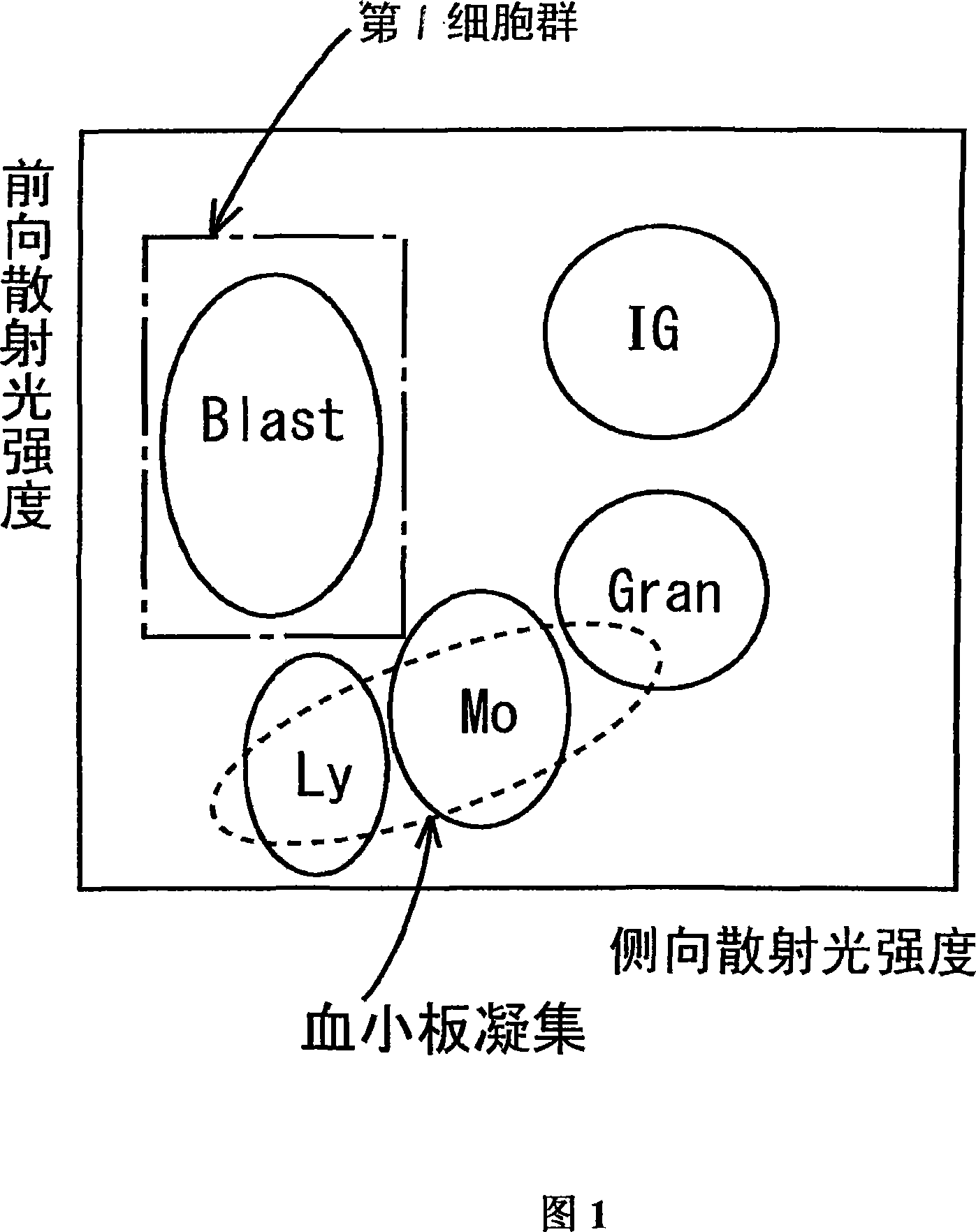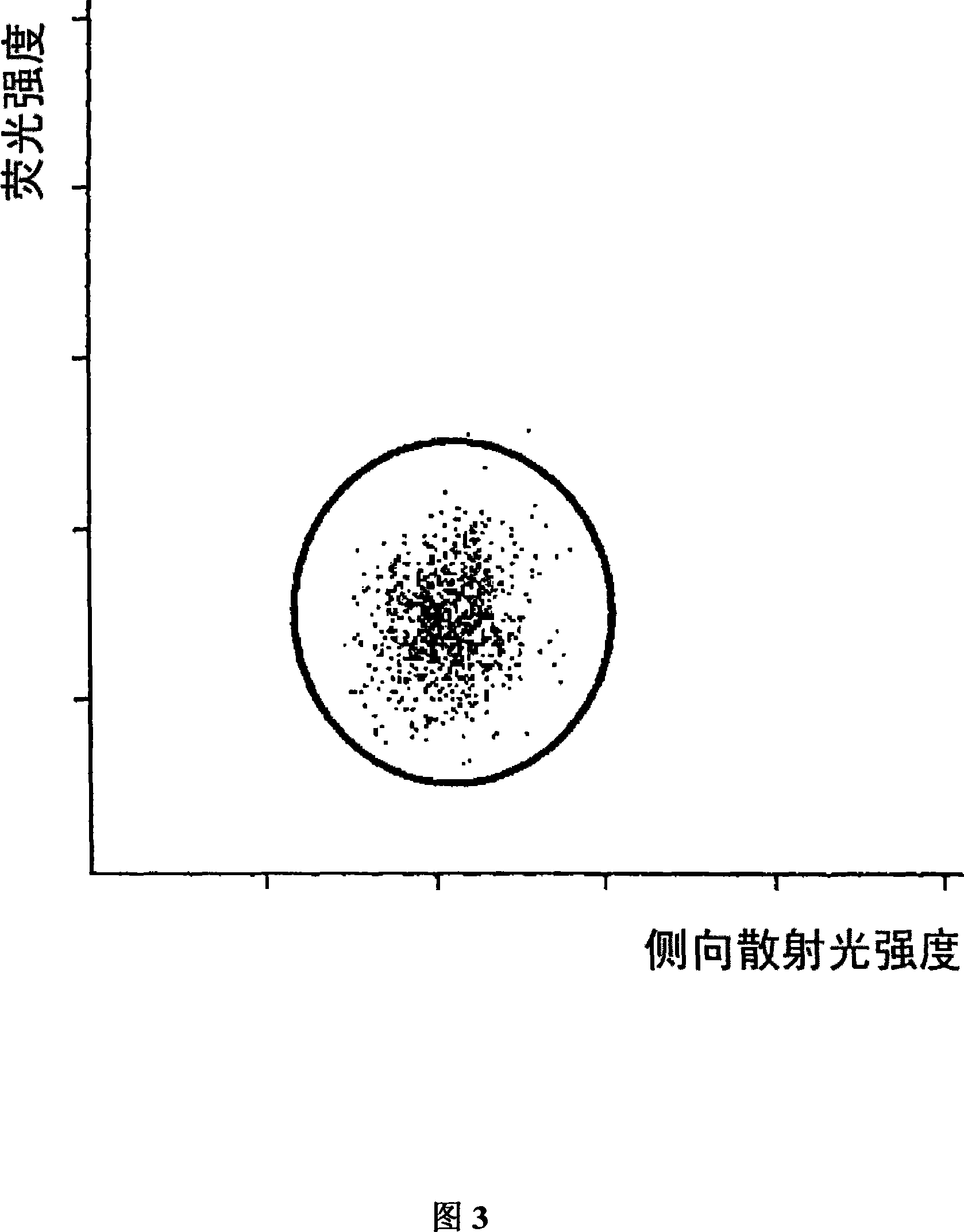Method and apparatus for measuring hematological sample
A technology for measuring devices and blood samples, applied in measuring devices, immunoassays, biological tests, etc., can solve the problems that appear in the area of white blood cells and red blood cells, and may appear in the area of bone marrow blasts in (3), and achieve Exclude platelet aggregation, accurate measurement effect
- Summary
- Abstract
- Description
- Claims
- Application Information
AI Technical Summary
Problems solved by technology
Method used
Image
Examples
preparation example Construction
[0100] [Preparation of samples for measurement]
[0101] A sample for measurement is prepared by mixing a solution containing the treatment reagent and a blood sample. If the above-mentioned kit is used, a solution containing a surfactant (hemolyzing agent) is first mixed with a blood sample, and then a dye is mixed to prepare a sample for measurement.
[0102] When blood sample and treatment reagent are mixed, the ratio of sample: treatment reagent is 1:10-1:1000, the reaction temperature is 20-40°C, and the reaction time is 3 seconds to 5 minutes, preferably 4 seconds to 1 minute.
[0103] In the measurement sample thus prepared, erythrocytes and mature leukocytes shrink smaller. In particular, red blood cells have no nuclei, and the hemolysis and cell shrinkage caused by damaged cell membranes are more serious, and the fluorescent pigment cannot be stained. Therefore, the forward scattered light, side scattered light and fluorescence are all weakened, which can be treated ...
experiment example
[0185] [blood sample]
[0186] The blood samples used were a sample containing a large amount of bone marrow blasts (sample A), a sample containing bone marrow blasts and immature leukocytes (sample B). Samples A and B contain platelet aggregation.
[0187] [Preparation of samples for measurement]
[0188] (1) Preparation of a measurement sample using the treatment reagent A
[0189] (A-1) Hemolytic agent
[0190] A hemolytic agent of the following structure containing the following components was prepared.
[0191] Glycine 19.5g / l
[0192] Polyoxyethylene(16) oleyl ether 25.0g / l
[0193] Sodium N-lauroyl sarcosinate 0.75g / l
[0194] HEPES 10mM
[0195] distilled water 11
[0196] Caustic soda pH up to 7.0
[0197] (A-2) Dyeing agent
[0198] Fluorescent dye A represented by the following formula was dissolved in ethylene glycol.
[0199]
[0200] The hemolytic agent and the blood sample are mixed, and the dyeing agent is added thereto until the final concentrati...
experiment example 1
[0211] Mix blood sample A and processing reagent B, react at 33°C for 5 seconds, prepare a sample, put the sample into a flow cell, and use a flow cytometer (light source: red semiconductor: wavelength: 633nm) to measure forward scattered light, side Scattered light and fluorescence. The measurement results were plotted as the first scatter plot with the forward scattered light intensity and the side scattered light intensity as the two axes (Fig. 13(A)) and the second scatter plot with the fluorescence intensity and the forward scattered light intensity as the two axes Figure (Fig. 13(B)).
[0212] In FIG. 13(A), the region where the first cell population appears is the solid line region. In FIG. 13(B), the region where the second cell population appears is the solid line region. In FIG. 13(A) , the expanded cell population containing lymphocytes partially overlaps with the first cell population.
[0213] The cell population contained in both the first cell population and ...
PUM
 Login to View More
Login to View More Abstract
Description
Claims
Application Information
 Login to View More
Login to View More - R&D
- Intellectual Property
- Life Sciences
- Materials
- Tech Scout
- Unparalleled Data Quality
- Higher Quality Content
- 60% Fewer Hallucinations
Browse by: Latest US Patents, China's latest patents, Technical Efficacy Thesaurus, Application Domain, Technology Topic, Popular Technical Reports.
© 2025 PatSnap. All rights reserved.Legal|Privacy policy|Modern Slavery Act Transparency Statement|Sitemap|About US| Contact US: help@patsnap.com



